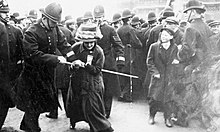
The Women's Social and Political Union (WSPU) was a women-only political movement and leading militant organisation campaigning for women's suffrage in the United Kingdom founded in 1903. Known from 1906 as the suffragettes, its membership and policies were tightly controlled by Emmeline Pankhurst and her daughters Christabel and Sylvia. Sylvia was eventually expelled.

Marion Wallace Dunlop was a Scottish artist, author and illustrator of children's books, and suffragette. She was the first and one of the most well known British suffrage activists to go on hunger strike on 5 July 1909, after being arrested in July 1909 for militancy. She was at the centre of the Women's Social and Political Union and designed some of the most influential processions of the UK suffrage campaign, as well as designing banners for them.

Leonora Cohen was an English suffragette and trade unionist, and one of the first female magistrates. She was known as the "Tower Suffragette" after smashing a display case in the Tower of London and acted as a bodyguard for Emmeline Pankhurst. She lived to the age of 105 and contributed to the second wave of feminism in the 1970s.

Olive Wharry was an English artist, arsonist and suffragette, who in 1913 was imprisoned with Lilian Lenton for burning down the tea pavilion at Kew Gardens.

Rose Elsie Neville Howey, known as Elsie Howey, was an English suffragette. She was a militant activist with the Women's Social and Political Union and was jailed at least six times between 1908 and 1912.
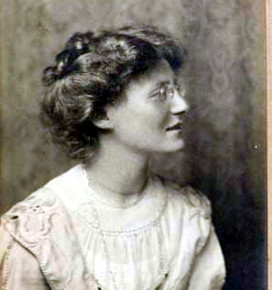
Leonora Helen Tyson was an English suffragette and member of the Women's Social and Political Union (WSPU).

Vera Wentworth was a British suffragette, who notably door-stepped and then assaulted the Prime Minister on two occasions. She was incarcerated for the cause and was force fed, after which she wrote "Three Months in Holloway"

Laura Frances Ainsworth was a British teacher and suffragette. She was employed by the Women's Social and Political Union and was one of the first suffragettes to be force-fed. She left the WSPU in 1912 in protest at the ejection of the Pethick-Lawrences, but continued to work for women's suffrage.

Florence Eliza Haig (1856–1952) was a Scottish artist and suffragette who was decorated for imprisonments and hunger strikes.

Maud Joachim was a member of the Women's Social and Political Union, one of the groups of suffragettes that fought for women to get the right to vote in the United Kingdom. She was jailed several times for her protests. Joachim was one of the first suffragettes to go on hunger strike when imprisoned, a protest at not being recognised as political prisoners.

Margaret Pollock McPhun was a Scottish suffragette from Glasgow who served two months in Holloway Prison in London and composed a poem about imprisoned activist Janie Allan.

Edith Hudson was a British nurse and suffragette. She was an active member of the Edinburgh branch of the Women's Social and Political Union (WSPU) and was arrested several times for her part in their protests in Scotland and London. She engaged in hunger strikes while in prison and was forcibly fed. She was released after the last of these strikes under the so-called Cat and Mouse Act. Hudson was awarded a Hunger Strike Medal 'for Valour' by the WSPU.
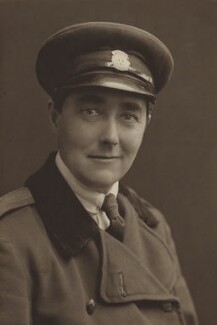
Olive Grace Walton (1886–1937) was a British Suffragette who was arrested three times, imprisoned twice, and force-fed in prison after going on a hunger strike.

The Hunger Strike Medal was a silver medal awarded between August 1909 and 1914 to suffragette prisoners by the leadership of the Women's Social and Political Union (WSPU). During their imprisonment, they went on hunger strike while serving their sentences in the prisons of the United Kingdom for acts of militancy in their campaign for women's suffrage. Many women were force-fed and their individual medals were created to reflect this.
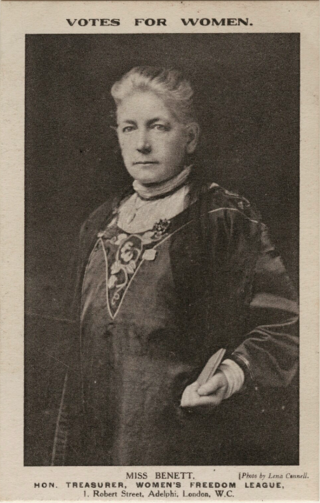
Sarah Barbara Benett was a suffragette, a member of the Women's Social and Political Union (WSPU) and Treasurer of the Women's Freedom League (WFL). She was one of the "Brown Women" who walked from Edinburgh to London in 1912 and went on hunger strike during her imprisonment in Holloway Prison for which she received the WSPU's Hunger Strike Medal and Holloway brooch.
Patricia Woodlock was a British artist and suffragette who was imprisoned seven times, including serving the longest suffragette prison sentence in 1908 ; she was awarded a Women's Social and Political Union (WSPU) Hunger Strike Medal for Valour. Her harsh sentence caused outrage among supporters and inspired others to join the protests. Her release was celebrated in Liverpool and London and drawn as a dreadnought warship, on the cover of the WSPU Votes for Women newsletter.
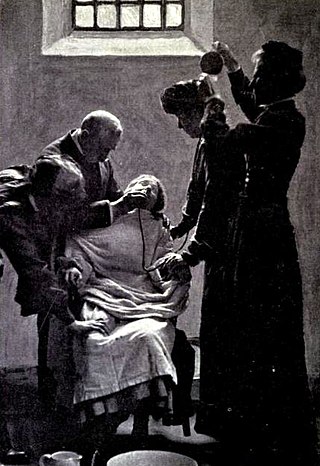
Alice Maud Shipley was a militant suffragette and member of the Women's Social and Political Union (WSPU) who received a prison sentence during which she went on hunger strike and was force-fed, for which action she received the WSPU's Hunger Strike Medal.

Bertha Wilmot Ryland was a militant suffragette and member of the Women's Social and Political Union (WSPU) who after slashing a painting in Birmingham Art Gallery in 1914 went on hunger strike in Winson Green Prison in Birmingham for which she was awarded the WSPU's Hunger Strike Medal.

The Suffragette Handkerchief is a handkerchief displayed at The Priest House, West Hoathly in West Sussex, England. It has sixty-six embroidered signatures and two sets of initials, mostly of women imprisoned in HMP Holloway for their part in the Women's Social and Political Union Suffragette window smashing demonstrations of March 1912. This was an act of defiance in a prison where the women were closely watched at all times.
Bertha Brewster was a British peace activist and suffragette who achieved fame with her letter to the Editor of The Daily Telegraph in February 1913. She was arrested five times, imprisoned twice and received the Hunger Strike Medal from the Women's Social and Political Union (WSPU).
